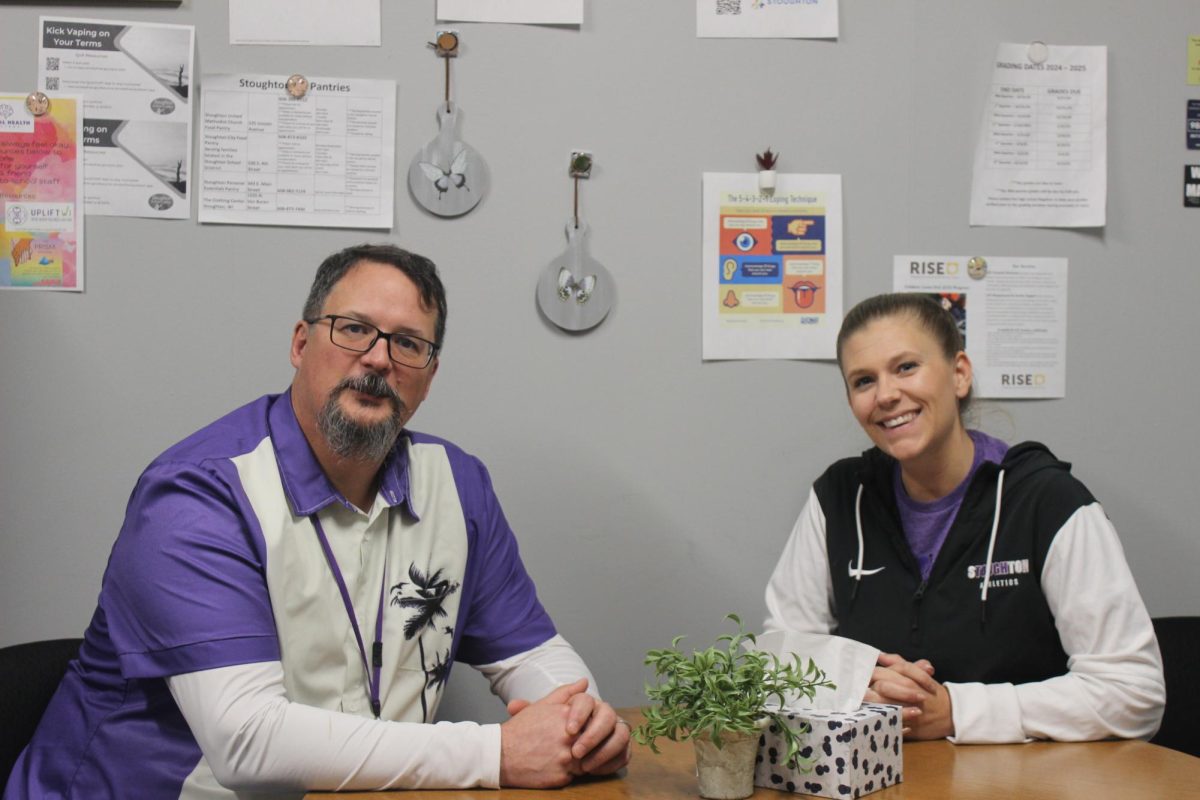Background and Context
This September, when students returned to Stoughton High School, a construction-filled cafeteria and new Viking pride-inspired floors weren’t the only changes they saw. With the new school year came a new principal and assistant principal.
After 16 years of service to SHS, head principal Mike Kruse retired following the 23-24 school year, and SHS associate principal Liz Hrodey resigned shortly thereafter. Hrodey’s departure marks a complete change for the school’s administration after associate principal Dana Schoemer left the district after the 22-23 school year.
Within just two years, all three of SHS’ principals left for a new job or retirement. With the changing times comes a “new opportunity for growth and continuous improvement,” in the words of SHS’s new principal Cassie Jemilo, a Stoughton resident and former faculty member at River Bluff Middle School. Jemilo most recently served as the associate principal of Northside Intermediate School, a grade 4-6 school in Milton, WI.
As SHS’ new principal Jemilo is implementing a series of changes hoping to make SHS a place where all students feel safe, accepted and have the resources to flourish. “Remember that you have the power to make a positive impact. Embrace every opportunity, support one another, use mistakes as an opportunity to learn, and always strive to be your best self. We can’t wait to see the incredible things you’ll accomplish! We love you all and are cheering you on every step of the way,” Jemilo said.
Jemilo’s administrative team includes Lance Masters, a second-year associate principal, and Emily Boyd, who is new to SHS after serving as a special education coordinator for the Monona Grove School District and as the assistant principal at Burlington High School. Boyd hopes her previous educator experience will help her understand the needs of students.
“My biggest part here is to be a facilitator between students and staff and to make sure that I have great relationships with everybody here, to make sure that I have the support they need to be their best selves,” Boyd said.
Working together to achieve what Jemilio calls a “unified mission of equity, inclusion, and student and faculty success,” these new SHS administrators are testing the waters by implementing a slate of new policies and initiatives to achieve a better schooling environment. “Our overarching goal is to become better people, and there are a lot of different ways to do that,” Masters said.
Although Masters points to a broad goal, he explains by using specific policies, the school community is more likely to meet this aspirational goal.
“When we get into the granular things, like the new cell phone policy or getting to class on time, those are the things that come with the overarching goal of becoming a better person. I see them as all connected, but being able to focus on each one and learn together about actions we can take will help us,” Masters said.
After a prolonged search for a new principal, Jemilio was selected by SASD District Administrator Dan Keyser, who called Jemilio a valuable asset who he hopes to be a long-term leader at SHS. Keyser selected Jemilo for the open position, and the Board of Education approved her contract in the early summer. Soon after being hired, Jemilio started to work, meeting with community leaders, faculty, and students. These community outreach initiatives are important to Jemilo’s larger vision for her time while at SHS and, as she explains, will help lay a productive foundation for her tenure. “Partnerships with families are crucial to student success, and together, we can ensure that SHS students thrive,” Jemilo said.
Despite being an SHS veteran compared to Jemilo and Boyd, Masters is still relatively new to his position, having served for just over a year. One of Masters’ lead initiatives is determining how 2+ is used each day. Despite being just 20 minutes of the school day, SHS administration hopes this seemingly minimal amount of time each day can achieve great significance for the student body. Masters and his new counterpart are working out their new vision for the usage of this time.
“I would love to see us utilize 2+ time as more of a flex or intervention time. Say, for example, you are struggling in an ELA class. I would like for students to feel as if they can more easily move about and go see a teacher and get the help they need,” Boyd said.
Just over a month into the job, Boyd shares how she is hopeful of what is yet to be achieved throughout the year and how her experience working directly with students will help make SHS a more accessible and involved learning environment.
“Being a team player and being collaborative is my favorite part of the day. When we find a student a youth apprenticeship or class they weren’t sure they wanted to take or allow them to take a risk and get students hooked up with the resources they need to be successful, just whatever they need to do their best job and be their best selves.” Boyd said.
A Wider Horizon
When you ask most students about the changes SHS is seeing, they will point to the large-scale construction, which is part of the $36 million 2022 referendum, or the recent crackdown on cell phone use in classrooms. However, district leadership is instituting multiple changes to address challenges facing students’ reading and math proficiency scores. SASD has also launched a revived effort to address mental health challenges at SHS.
When Stoughton voters approved the 2024 Operational Referendum, funds became available to hire five new full-time employees, four of which are math and reading interventionists, two for K-5, and two for 6-12. These interventions are a part of the district’s goal to lower the numeracy and literacy achievement gaps.
“Along with strengthening our culture and climate, our school goals are to improve our math and literacy skills and provide equitable instruction for all learners. We set ambitious goals to increase student proficiency in Math and Reading by 10% during the 2024-2025 school year.” Jemilo said.
Mental health is also a priority among district and building leaders. SASD promotional material claimed that the new funding approved by the multi-million dollar referendum would fund “additional staff to support students with reading and math achievement and mental health.” The district has since implemented a new position, which they refer to as a “coach,” aimed at helping support buildings with social-emotional, mental health, and behavioral needs. The position has since been filled by a special education teacher who was already employed by the district.
The increase in mental health issues continues to be a top concern for SASD and school and health experts across the nation. The Wisconsin Department of Public Instruction found that 19% of WI high school students have considered committing suicide, which points to the crisis schools are facing across the state. DPI’s annual Youth Risk Behavior Survey found that nearly 80% of WI students spend over 3 hours a day on their phones, which is above the Mayo Clinic’s recommendation of no more than 2 hours a day. The DPI survey also found that “Wisconsin students continue to report less sleep and worsened overall physical health.” Many of these health issues can be linked back to excessive screen time. 41% of survey students reported using social media hourly, including at school.
This increase in phone usage during all hours of the day is what may be contributing to a spike in mental health-related issues. SASD is implementing new policies to address cell phone usage to reduce mental health issues and refocus students on learning during instructional time.
The Cell Phone Policy
One new policy put into place by the new SHS administration regards personal communication devices (PCDs). The district-wide policy adopted by the board of education on July 1, 2021, states, “Students may use PCDs before and after school, during their lunch break, in between classes as long as they do not create
a distraction, disruption or otherwise interfere with the educational environment, during after-school activities, or at school-related functions”. (po5136) The board policy goes on to acknowledge exceptions to this policy when PCDs are used as a part of classroom instruction.
This board policy is a near parallel to the seemingly “new” PCD policy students are seeing this school year, but it is simply the active implementation of an already-standing policy.
The implementation has faced mixed reviews, but its purpose is rooted in achieving an overall vision of student belonging and academic success.
“When we look at student engagement, that is where we are starting with the cellphone policy,” Boyd said.
Building administration hopes that by removing PCDs as a distraction during class, students can refocus on teacher instruction and also remove what many link to a cause of the spike in mental health issues.
In general, the SHS administration reports that the implementation of the newly enforced policy is going well.
“We have had under 10 cell phone referrals in that time. There are times where cell phones are still an issue, but you give one reminder, and I have gotten really good feedback,” Boyd said.
Boyd goes on to explain that she expected students to be less receptive to the enforcement and that teachers and administrators would be more consumed with policing cellphone usage.
“I assumed that every single day for the first three weeks, I would be chasing cellphones. However, the idea is that implementation is going well.” Boyd says.
Many students understand the intent but feel as if it is misguided. According to a survey conducted by the SASD administration, 88% of students feel that cellphones are an issue in school. SHS senior Alex Thiessen believes that these policies are in the best interest of the student body and that although they may not be the most popular, they are necessary at the end of the day. “ It is (the newly implemented PCDs policy) forcing kids to focus more on school and each other,” Thiessen said.
The new PCDs policy is just a part of the new administration’s take on SHS, Thiessen explains. He hopes that it’s just the start of a larger revamp of SHS. “I think with obviously a lot of new administrators that comes new life and energy. And I think that’s really exciting, and it’s cool to see, and hopefully it continues throughout the rest of the year.” Thiessen said.
Another supporter of these new policies is SHS senior Danil Kostetskyi, who understands where policies like the PCDs policy come from. “While I may not have always liked certain rules […] I understood that these measures were implemented to maintain discipline and order in our school.”
However, SHS senior Ava Mueller feels like the policy isn’t solving the screen problem for those who need it most.
“Regardless of if there is a policy or not, kids that want to focus and succeed in class will stay off their phones, and kids that don’t will use their phones,” Mueller said.
The policy’s “one-size-fits-all” implementation isn’t meeting the needs of the students at the greatest risk, she goes on to explain. “It hasn’t stopped kids from using their phones/ear buds during class […] I don’t think it has been very successful.”
Mueller says SHS administration has been using a one-size-fits-all approach as a solution to many issues they face, she points to the closing of bathrooms throughout the school to prevent vandalism, class cutting, and other prohibited activities. “We need to find a better solution,” Mueller said.
Similar to Mueller, another SHS senior, Brianna Woelke, says she respects the intent of the CPD policy but feels as if it is unrealistic and unfairly affects students who may use their phones from time to time, but it isn’t impacting their learning. Woelke makes specific note of the implementation regarding earbuds and portable music devices, which, in many cases, is considered use of a CPD.
“During work time, or if you’re not doing anything in class, I think it should be okay to have earbuds in and listen to music because it can actually help a lot of kids relax and get their work done,” Woelke said.
Initially, the CPD Student Agreement that the SHS administration presented to students and staff claimed that both cellphone use and earbud use were not permitted while in class without explicit teacher permission. However, after feedback from students, the SHS administration updated their guidelines to accommodate earbud use.
“We initially rolled out no AirPods, no any sort of earbuds in class, […] but after listening to students feedback has helped us shift that policy,” Boyd said.
She goes on to explain how the intent behind the cellphone policy isn’t to teach students not to use their phones but how to use them appropriately while in the classroom.
“The idea of phones not in school at all is not teaching students how to be responsible and well-meaning adults. We are doing a really good job of teaching students how and when to use their phones.” Boyd said.
But Woelke makes note of how the implementation of the CPD policy has affected students who may not be a prime target of the policy.
“I think it’s not [been successful], the people that they are trying to help with this phone policy, well, it’s not working because if they wanna be on their phone, then they’re just gonna be on it. You take their phone, then they go on their Chromebooks and play games,” Woelke says.
The ultimate success of these new initiatives is yet to be seen; a lot lies ahead, and the success or failure of these new initiatives regarding mental health, cellphone usage, and reading and math achievement are yet to be seen. SHS administration continues to praise the need for student input and involvement and hopes that by working together, students, staff, and administrators will create a more enjoyable SHS. “Education is a shared responsibility between the school, families, and the community. By working together, we can make sure that each student receives the support and resources they need.” Jemilo said.
Despite these calls for student engagement and involvement, SHS students remain weary.
“Administration usually tries their best to listen to students, but they don’t often take action. I don’t think they are very in touch with the concerns and needs of students, even though they say they are,” Mueller said.
Nonetheless, Kostetskyi stays optimistic as to what policies like the CDP policy will help our school become. “I believe the new administration will achieve even more for our school.”









